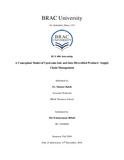A conceptual model of upstream jute and jute diversified products’ supply chain management

View/
Date
2018-12Publisher
BRAC UniversityAuthor
Rifath, Md. FatauzzamanMetadata
Show full item recordAbstract
Bangladesh is one of the leading manufacturers and exporters of jute and jute diversified goods and the export market is becoming more attractive day by day because globally people are becoming more environment conscious. As a result they are rejecting plastics, polypropylenes and other synthetic materials and giving more focus on ecofriendly materials like jute. To do these exporting processes Bangladesh jute industry had to go through a number of supply chain activities. But these supply chain activities are neither effective nor efficient because of some problems. This research attempts to identify the upstream supply chain model of Bangladesh jute and jute diversified products’ industry. Furthermore, the study also analyze each and every steps of upstream supply chain and tries to identify the problems of those stages. Firstly, the paper has analyzed theoretical models of basic supply chain in manufacturing and service industry. The paper has also discussed some previous studies regarding market functions and supply channels of Bangladesh jute industry. Based on the theoretical models, previous studies, primary and secondary data the research has developed a conceptual model of upstream supply chain which includes four stages. Those stages are suppliers, farmers or the producers, intermediaries and the mills. However, If the raw jute is directly exported from Bangladesh than the intermediaries are the last part of upstream supply chain. To demonstrate a clear picture, the research has also discussed the downstream supply chain part of jute exporting business. While discussing the stages, the research also attempted to identify the characteristics and roles of each and every players of the supply chain. Besides, the study also shows how each and every players are adding values in different stages of supply chain. This analysis helped to identify the strong and most dominating player as well as most deprived player in upstream jute industry supply chain. Lastly the research has mentioned some recommendations for the betterment of jute industry. This research will be very helpful for the manufacturing and trading companies who are engaged with jute industry. Furthermore it will also help the upstream supply chain players of jute industry to identify their problems and make their operations more effective and efficient.
